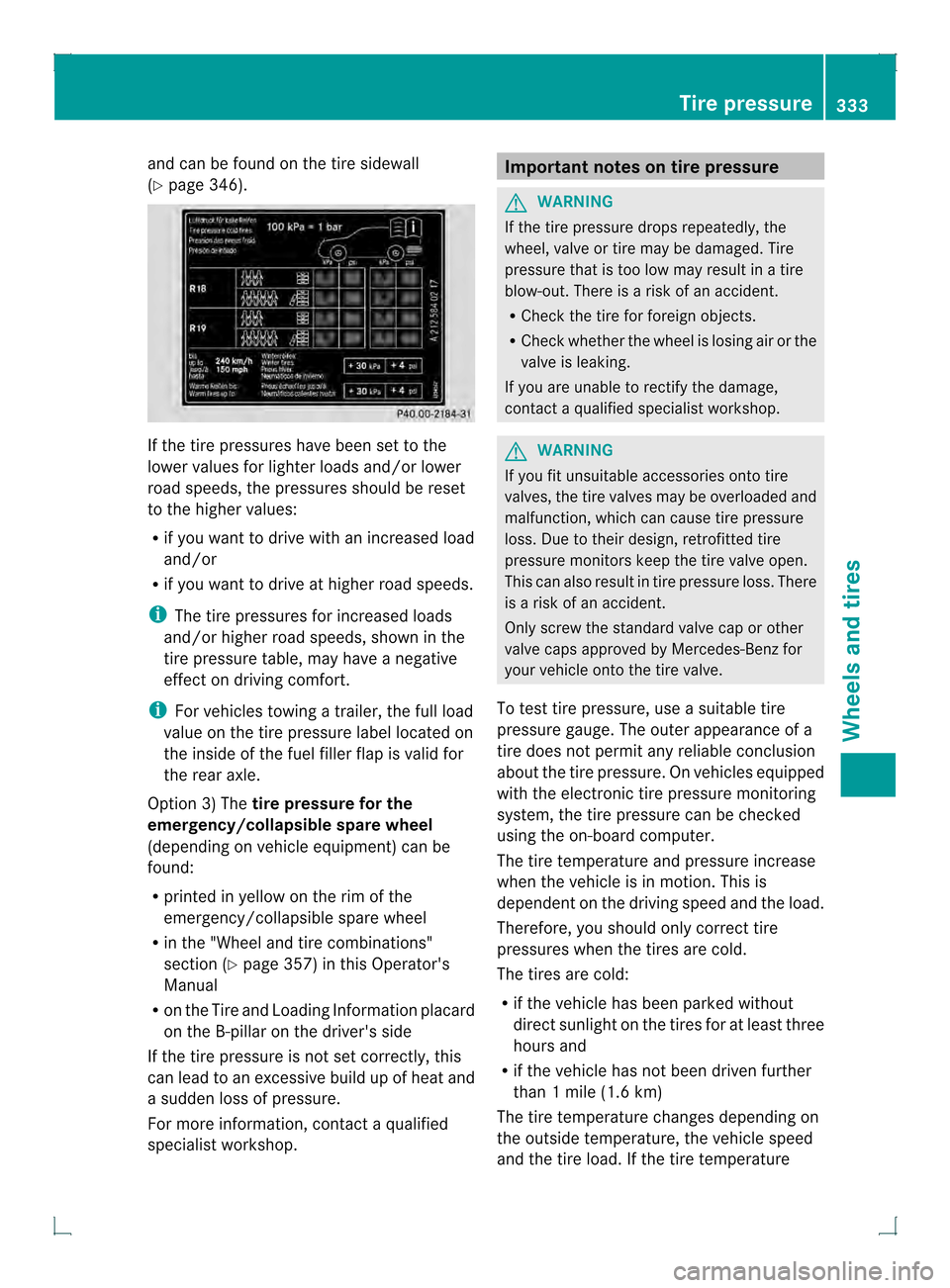2013 MERCEDES-BENZ GLK-Class tire pressure reset
[x] Cancel search: tire pressure resetPage 21 of 378

Tire bead (definition
)...................... 351
Tire pressure (definition) ................351
Tire pressures (recommended )...... 349
Tire size (data) ............................... 357
Tire size designation, load-bearing
capacity, speed rating .................... 346
Tire tread ....................................... 329
Tire tread (definition) .....................351
Total load limit (definition) .............352
Traction ......................................... 344
Traction (definition) .......................351
Trea dwear ..................................... 344
TWR (permissible trailer drawbar
noseweight) (definition) .................351
Uniform Tire Quality Grading
Standard s...................................... 344
Uniform Tire Quality Grading
Standard s(definition) .................... 349
Unladen weight (definition) ............350
Wea rindicato r(definition) .............352
Whee lrim (definition ).................... 349
see Flat tire
Top Tether ............................................ 62
Towing Important safety guidelines ...........320
Installing the towing eye ................321
Removing the towing eye. ..............321
With the rear axle raised ................322
Towing atrailer
Activ eParking Assist ..................... 188
Cleaning the trailer tow hitch ......... 308
Coupling up atrailer ...................... 210
Decoupling atrailer ....................... 212
Driving tips .................................... 208
Important safety notes ..................208
Installing the ball coupling .............210
Lights displa ymessage .................. 239
Mounting dimensions ....................374
Power supply ................................. 213
Removing the ball coupling ............213
Shift range ..................................... 151
Storing the ball coupling ................213
Trailer loads ................................... 374
Towing away
With both axles on the ground .......322
Tow-starting
Emergency engine starting ............323
Important safety notes ..................320Trailer coupling
see Towing atrailer
Trailer loads and drawbar
noseweights ...................................... 212
Trailer towing Active Blind Spot Assist .................205
Active Lane Keeping Assist .... 202, 208
Blind Spot Assist ............................ 200
PARKTRONI C................................. 183
Permissible trailer loads and
drawba rnoseweights ..................... 212
Transfer case ..................................... 154
Transmission see Automatic transmission
Transmission position display .........149
Transmission position display
(DIRECT SELECTl ever)...................... 149
Transporting the vehicle ..................322
Traveling uphill Brow of hill ..................................... 169
Driving downhill ............................. 169
Maximum gradient-climbing
capability ....................................... 169
Trim pieces (cleaning instructions) .309
Trip computer (on-board computer) 219
Trip odometer Calling up ....................................... 219
Resetting (on-board computer) ......220
see Trip odometer
Turn signals
Changing bulbs (front) ...................119
Display message ............................ 240
Switching on/off ........................... 112
see Turn signals
TWR (Tongue Weight Rating)
(definition) ......................................... 351
Type identification plate see Vehicle identification plate U
Unlocking Emergency unlocking .......................81
From inside the vehicle (central
unlocking button) ............................. 80 Index
19
Page 335 of 378

and can be found on th
etire sidewall
(Y page 346). If the tire pressures have been set to the
lower values for lighter loads and/or lower
road speeds, the pressures should be reset
to the higher values:
R if you want to drive with an increased load
and/or
R if you want to drive at higher road speeds.
i The tire pressures for increased loads
and/or higher road speeds, shown in the
tire pressure table, may have a negative
effect on driving comfort.
i For vehicles towing a trailer, the full load
value on the tire pressure label located on
the inside of the fuel filler flap is valid for
the rear axle.
Option 3) The tire pressure for the
emergency/collapsible spare wheel
(depending on vehicle equipment) can be
found:
R printed in yellow on the rim of the
emergency/collapsible spare wheel
R in the "Wheel and tire combinations"
section (Y page 357) in this Operator's
Manual
R on the Tire and Loading Information placard
on the B-pillar on the driver's side
If the tire pressure is not set correctly, this
can lead to an excessiv ebuild up of heat and
a sudde nloss of pressure.
For more information, contact a qualified
specialist workshop. Important notes on tire pressure
G
WARNING
If the tire pressure drops repeatedly, the
wheel, valve or tire may be damaged. Tire
pressure that is too low may result in a tire
blow-out. There is a risk of an accident.
R Check the tire for foreign objects.
R Check whether the wheel is losing air or the
valve is leaking.
If you are unable to rectify the damage,
contact a qualified specialist workshop. G
WARNING
If you fit unsuitable accessories onto tire
valves, the tire valves may be overloaded and
malfunction, which can cause tire pressure
loss. Due to their design, retrofitted tire
pressure monitors keep the tire valve open.
This can also result in tire pressure loss. There
is a risk of an accident.
Only screw the standard valve cap or other
valve caps approved by Mercedes-Benz for
your vehicle onto the tire valve.
To test tire pressure, use a suitable tire
pressure gauge. The outer appearance of a
tire does not permit any reliable conclusion
about the tire pressure. On vehicles equipped
with the electronic tire pressure monitoring
system, the tire pressure can be checked
using the on-board computer.
The tire temperature and pressure increase
when the vehicle is in motion .This is
dependent on the driving speed and the load.
Therefore, you should only correct tire
pressures when the tires are cold.
The tires are cold:
R if the vehicle has been parked without
direct sunlight on the tires for at least three
hours and
R if the vehicle has not been driven further
than 1 mile (1.6 km)
The tire temperature changes depending on
the outside temperature, the vehicle speed
and the tire load. If the tire temperature Tire pressure
333Wheels and tires Z